Being tired after making a long journey, you may wonder where else you can have entertainment. Beijing Happy Valley can fully satisfy your desire. Located in the southeast corner of Sifang Bridge, on the fourth ring road, in Chaoyang District in Beijing, it is your happy theme park, another Disneyland in Mainland China. Covering an area of 1,000,000 square kilometers (386,102 square miles), it has been open to tourists since 2006 and attracted a lot of visitors from home and abroad.
Thematic Landscapes
Beijing Happy Valley is composed of six theme parks, including Firth Forest, Atlantis, Aegean Sea, Lost Maya, Shangri-La and Ant Kingdom. More than 50 scenic sights of culture and ecology are scattered in all direction, to offer you a rare opportunity to experience the charm of various civilizations regardless of the distance of space and time. The full extent of the valley is compared to a beautiful artistic picture where you can see tree houses, docks, bridges, towns, ancient towers, lakes, forests and other amazing scenic spots beyond your imagination. After going through the famous 'ecological forest' in Firth Forest, the first sight you will see is the high-rising Crystal City. There you can have a close contact with those figures of ancient Greek myths in Aegean Sea. Recall the glorious Maya and their scattered huge stone pillars. Enjoy the happiness of simple life in dreamy Shangri-la. Wake up the child within you, and love for nature in Ant Kingdom. Beijing Happy Valley will fully satisfy your desire and curiosity.
Thematic Leisure Activities
Pop Music Festival: The super band is creating a grand music ceremony for you. Surrender to those deafening rhythms, marvelous sounds and hot dances that can easily arouse your excitement.
Maximal Exercise Festival: Your eyes will be feasted on all sorts of performance. It's a most exciting and healthy festival of praising youth. Don't hesitate to take part in the latest crazes from skateboards to bicycle riding. It's up to you!
Chinese Spring Festival: You will be attracted by every splendid program in this riotous atmosphere. Performances with strong ethnic flavor will bring a fantastic visionary taste.
Water-Splashing Festival: Water symbolizes luck and wealth. On Water-Splashing Festival, people sprinkle water onto each other as a unique way to express their good wish. Come here and enjoy the cool and happy moment.
International Magic Day: Magicians of the first rank from all over the world present distinct magic tricks for you. Keep your eyes on this magical world full of suspension.
Thematic ParkThematic Park is composed of six parts: Firth Forest, Atlantis, Aegean Sea, Lost Maya, Shangri-La and Ant Kingdom. Each of them has its own feature, but all of them can fully satisfy your desire of seeking happiness.
Tips:
To make your journey more convenient and comfortable, you can take a trainset, wecker, or electric power cart in the park.
Price of trainset\wecker: CNY 20. Children under 1.2 meters (4 feet) are ticket-free, between 1.2 (4 feet) to 1.4 meters (4 feet 7 inches) pay half price.
Price of single electric power cart: deposit: CNY 300, you need pay CNY 30 for half an hour journey and CNY 60 for one hour journey.
You can take bus No.52 at Tiananmen Square and get off at East Jinsongqiao Station to take bus No.41 and get off at South Houfengqiao Station. Or you can take a subway and get off at Dawang Road Station to change bus No.31 and get off at South Houfengqiao Station.
Please consult the day's notice for changes and the Beijing Happy Valley Performance Time.
| Admission Fee: (All Inclusive Ticket) | CNY 160 (Apr.1-Nov.14) CNY 120 (Nov.15-Mar.31) |
| Opening Hours: | 09:00-19:30 (weekday) 08:30-19:30 (weekend) |
| Ticket-Selling Hours: | 09:30-16:00 |
.jpg)
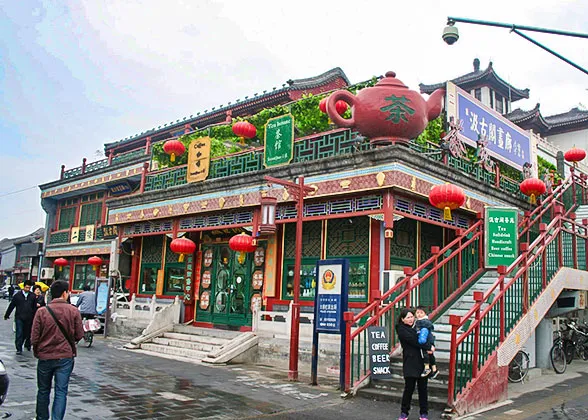 If you have a favor with curios, calligraphy, painting or other artwork in China, Liulichang Street of Chinese Culture is a must when you travel in Beijing.
If you have a favor with curios, calligraphy, painting or other artwork in China, Liulichang Street of Chinese Culture is a must when you travel in Beijing.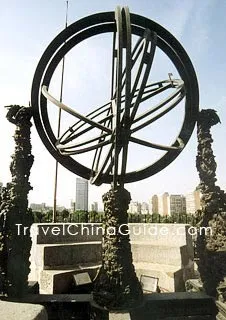
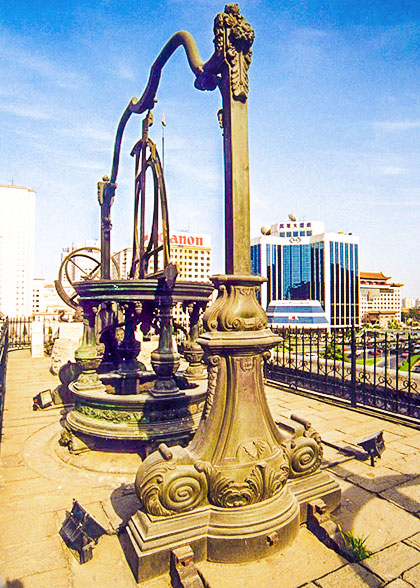
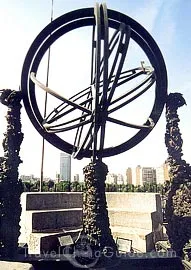
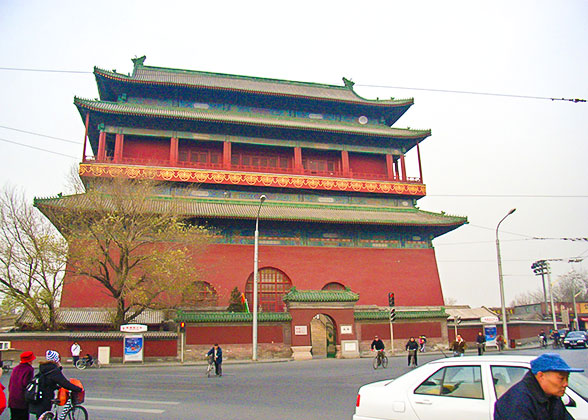 This brick and stone towers have two floors: there is an arched door on all four sides of the tower on the first floor, and you can go up to the second floor through stone stairs. The same exists on the first floor. An arched door was also built on the four sides of the second floor. Additionally, there is a stone window on each side of the four doors. Hanging on an eight-square wooden frame of the second floor, the bell in this tower is the largest and heaviest in China. It is 7.02 meters (23 feet) high including the pendants, with a weight of 63 tons (138,891 pounds). The bell was made of copper, and you can hear its round and clear sound from far away. The two 2-meter-long (2 yards) wooden logs hanging sideward are used to ring the bell.
This brick and stone towers have two floors: there is an arched door on all four sides of the tower on the first floor, and you can go up to the second floor through stone stairs. The same exists on the first floor. An arched door was also built on the four sides of the second floor. Additionally, there is a stone window on each side of the four doors. Hanging on an eight-square wooden frame of the second floor, the bell in this tower is the largest and heaviest in China. It is 7.02 meters (23 feet) high including the pendants, with a weight of 63 tons (138,891 pounds). The bell was made of copper, and you can hear its round and clear sound from far away. The two 2-meter-long (2 yards) wooden logs hanging sideward are used to ring the bell.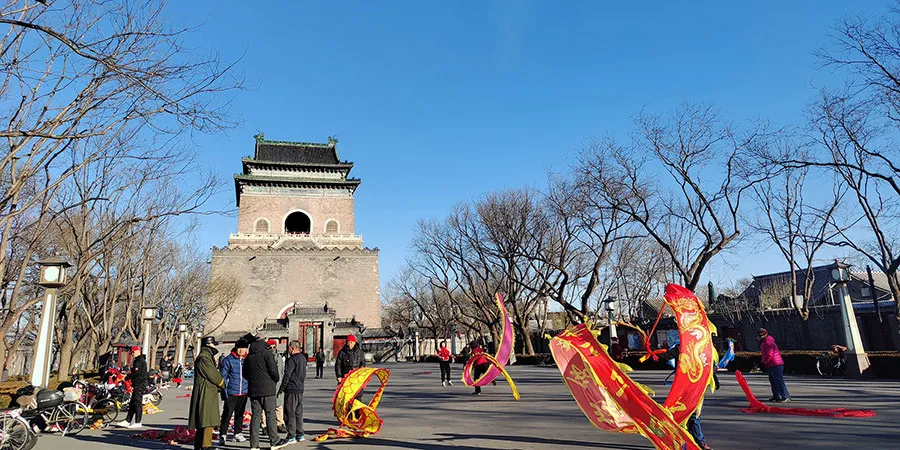 Located 100 meters (109 yards) south to the bell tower, the drum tower was placed on a 4-meter-high (13 feet) stone and brick base. It is 46.7 meters (153 feet) high, a little bit lower than the bell tower that is 47.9 meters high (157 feet). This tower is also a two-storey building; the first floor contains the China Committee for the Promotion of the Minority Art. The second floor contains the exhibition area. Originally, there was one big drum and 24 smaller drums, but only the big drum remains. The method of beating the drum is to beat it quickly for 18 times and then slowly for 18 times. Altogether there are three rounds and 108 tollings. People knock the bell and the drum 108 times, because 108 times represent one year in ancient times.
Located 100 meters (109 yards) south to the bell tower, the drum tower was placed on a 4-meter-high (13 feet) stone and brick base. It is 46.7 meters (153 feet) high, a little bit lower than the bell tower that is 47.9 meters high (157 feet). This tower is also a two-storey building; the first floor contains the China Committee for the Promotion of the Minority Art. The second floor contains the exhibition area. Originally, there was one big drum and 24 smaller drums, but only the big drum remains. The method of beating the drum is to beat it quickly for 18 times and then slowly for 18 times. Altogether there are three rounds and 108 tollings. People knock the bell and the drum 108 times, because 108 times represent one year in ancient times.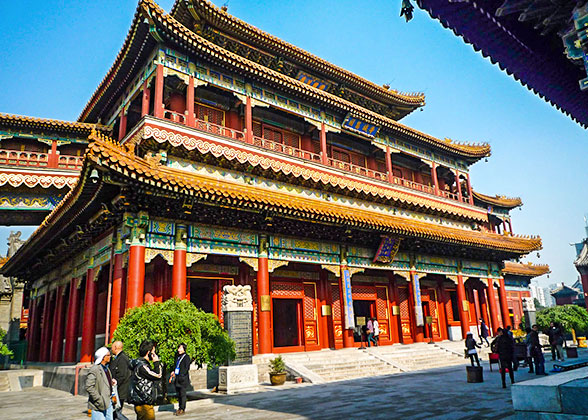 At the northeast corner of Beijing City the traveler will find an elegant and ancient temple known as the Yonghe Lamasery, which is the largest and most perfectly preserved lamasery in present day China.
At the northeast corner of Beijing City the traveler will find an elegant and ancient temple known as the Yonghe Lamasery, which is the largest and most perfectly preserved lamasery in present day China.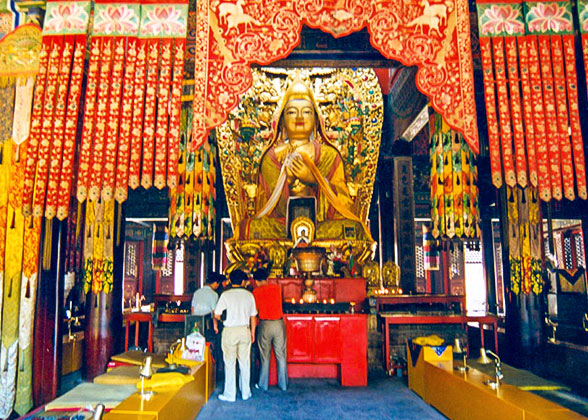 Yonghe Gate, originally the main entrance to the Lamasery is now called Devaraja Hall (Hall of the Heavenly Kings), as there are the statues of four very powerful Heavenly Kings located on both sides of the inner palace walls. The northern Heavenly King on the eastern side holds a snake and treasures; the southern King on the eastern side holds an umbrella and a silver mouse; the southern one on the western side holds a sword and the northern one on the western side holds a Pipa (a musical instrument used in ancient China). Located in the centre of the Palace is a smiling Maitreya.
Yonghe Gate, originally the main entrance to the Lamasery is now called Devaraja Hall (Hall of the Heavenly Kings), as there are the statues of four very powerful Heavenly Kings located on both sides of the inner palace walls. The northern Heavenly King on the eastern side holds a snake and treasures; the southern King on the eastern side holds an umbrella and a silver mouse; the southern one on the western side holds a sword and the northern one on the western side holds a Pipa (a musical instrument used in ancient China). Located in the centre of the Palace is a smiling Maitreya.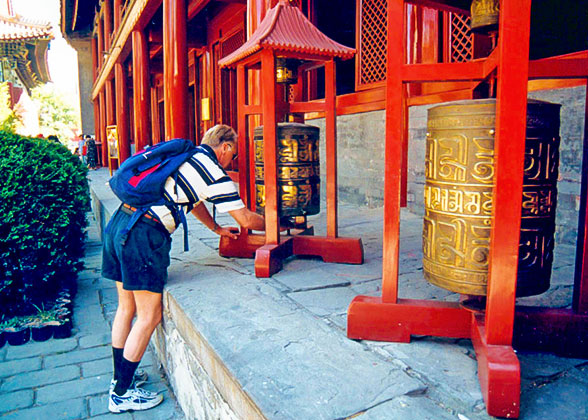 From Yongyoudian continue north to the Falundian (Hall of the Wheel of the Law), which is the location for Lamas reading scriptures and holding Buddhist ceremonies. The Falundian comprises very special features as its structure contains the architectural styles of both Tibetan and Han Nationalities. It was formerly the dwelling of the Emperor's wives. A large statue of Tsong Kha-pa, an ancestor of Lamaism is displayed here in the centre of the Hall and also receives sacrificial offerings. Behind this statue is an Arhat Hill containing 500 Arhats made of five kinds of metals--gold, silver, copper, iron and tin. These Arhats have been shaped in different poses. In front of this Hill is a wooden basin which was said to have been used for washing the body of Emperor Qianlong three days after his birth. Elegant large frescos illustrating the life of Sakyamuni stretch around both the east and west walls.
From Yongyoudian continue north to the Falundian (Hall of the Wheel of the Law), which is the location for Lamas reading scriptures and holding Buddhist ceremonies. The Falundian comprises very special features as its structure contains the architectural styles of both Tibetan and Han Nationalities. It was formerly the dwelling of the Emperor's wives. A large statue of Tsong Kha-pa, an ancestor of Lamaism is displayed here in the centre of the Hall and also receives sacrificial offerings. Behind this statue is an Arhat Hill containing 500 Arhats made of five kinds of metals--gold, silver, copper, iron and tin. These Arhats have been shaped in different poses. In front of this Hill is a wooden basin which was said to have been used for washing the body of Emperor Qianlong three days after his birth. Elegant large frescos illustrating the life of Sakyamuni stretch around both the east and west walls.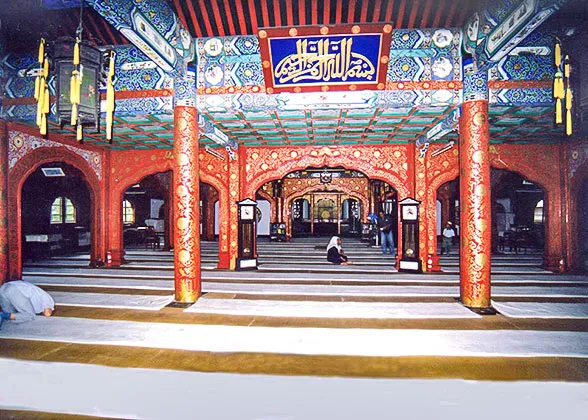 Beijing's most historical and majestic mosque, The Niujie (Ox Street), is situated on Niujie Street in the city's Xuanwu District. First built back in 996, the mosque has a history that stretches back over a thousand years, in which time it has undergone numerous refits and extensions, and has greeted Muslims from all over the world to worship. The mosque covers an area of over 6000 square meters (7176 square yards), and is structurally based on traditional Chinese wooden palaces, yet adopts a typical Arabic-style of decoration. There are no human or animal figures among these decorations as these are considered taboo in Islam.
Beijing's most historical and majestic mosque, The Niujie (Ox Street), is situated on Niujie Street in the city's Xuanwu District. First built back in 996, the mosque has a history that stretches back over a thousand years, in which time it has undergone numerous refits and extensions, and has greeted Muslims from all over the world to worship. The mosque covers an area of over 6000 square meters (7176 square yards), and is structurally based on traditional Chinese wooden palaces, yet adopts a typical Arabic-style of decoration. There are no human or animal figures among these decorations as these are considered taboo in Islam. Walking along the path that runs beside the tower, visitors eventually reach the Prayer Hall - the most important building in the mosque. It is a place only open to Muslims. Covering an area of 600 square meters (718 square yards), the hall has the capacity for a few thousand worshippers. The hall's arched gate is decorated with script from the Koran and poems of worship. Some of the text is written in the ancient Arabic characters of Al-Kufi, which is rarely seen in China. The room is also adorned with various paintings of flowers, strings of glass beads and colored glass, which contribute to the hall's air of great importance and holiness.
Walking along the path that runs beside the tower, visitors eventually reach the Prayer Hall - the most important building in the mosque. It is a place only open to Muslims. Covering an area of 600 square meters (718 square yards), the hall has the capacity for a few thousand worshippers. The hall's arched gate is decorated with script from the Koran and poems of worship. Some of the text is written in the ancient Arabic characters of Al-Kufi, which is rarely seen in China. The room is also adorned with various paintings of flowers, strings of glass beads and colored glass, which contribute to the hall's air of great importance and holiness.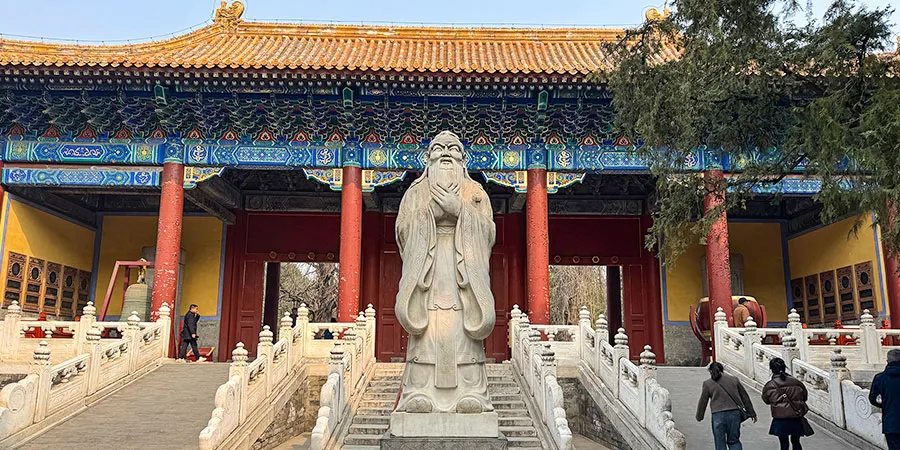 Located on Guozijian Street inside Anding Gate, the Temple of Confucius in Beijing is the place where people paid homage to Confucius during the Yuan Dynasty (1271-1368), Ming Dynasty (1368-1644) and Qing Dynasty (1644-1911). Now the temple houses the Beijing Capital Museum.
Located on Guozijian Street inside Anding Gate, the Temple of Confucius in Beijing is the place where people paid homage to Confucius during the Yuan Dynasty (1271-1368), Ming Dynasty (1368-1644) and Qing Dynasty (1644-1911). Now the temple houses the Beijing Capital Museum.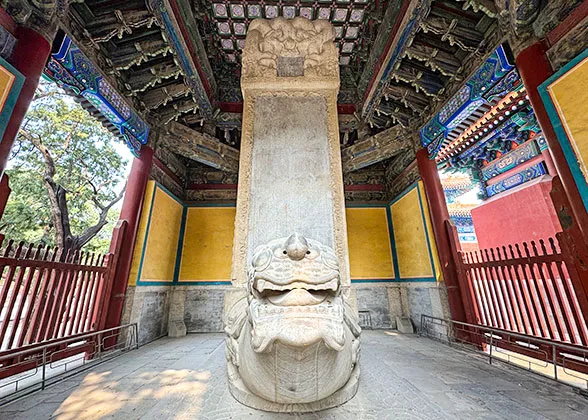 One item of note is the 700-year-old Chujian Bai (Touch Evil Cypress) in the temple. Its name is associated with an ancient legend. During the Ming Dynasty, one day the superior official-Yan Song came to worship Confucius on behalf of the emperor. When he was passing by the cypress, one of the branches of the tree took his hat off. Since Yan Song was a treacherous official, people have thought the old tree could distinguish between good and evil people. Hence its name.
One item of note is the 700-year-old Chujian Bai (Touch Evil Cypress) in the temple. Its name is associated with an ancient legend. During the Ming Dynasty, one day the superior official-Yan Song came to worship Confucius on behalf of the emperor. When he was passing by the cypress, one of the branches of the tree took his hat off. Since Yan Song was a treacherous official, people have thought the old tree could distinguish between good and evil people. Hence its name. The Temple of Heaven is a worthwhile visiting place in Beijing. It is much bigger than the Forbidden City and smaller than the Summer Palace with an area of about 2,700,000 square meters. The Temple was built in 1420 A.D. during the Ming Dynasty to offer sacrifice to Heaven. As Chinese emperors called themselves 'The Son of Heaven' ,they dared not to build their own dwelling,'Forbidden City' bigger than a dwelling for Heaven.
The Temple of Heaven is a worthwhile visiting place in Beijing. It is much bigger than the Forbidden City and smaller than the Summer Palace with an area of about 2,700,000 square meters. The Temple was built in 1420 A.D. during the Ming Dynasty to offer sacrifice to Heaven. As Chinese emperors called themselves 'The Son of Heaven' ,they dared not to build their own dwelling,'Forbidden City' bigger than a dwelling for Heaven.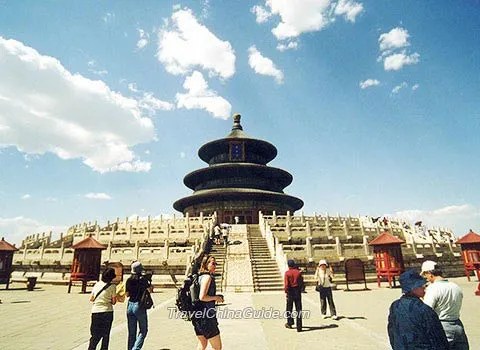 The Circular Altar has three layered terraces with white marble. During the Ming and Qing Dynasties (1368 A.D. - 1911 A.D.), the emperors would offer sacrifice to Heaven on the day of the Winter Solstice every year. This ceremony was to thank Heaven and hope everything would be good in the future. The Hall of Prayer for Good Harvest is a big palace with round roof and three layers of eaves. Inside the Hall are 28 huge posts. The four posts along the inner circle represent four seasons-spring, summer, autumn and winter; the 12 posts along the middle circle represent the 12 months; and 12 posts along the outer circle represent 12 Shichen (Shichen is a means of counting time in ancient China. One Shichen in the past equaled two hours and a whole day was divided into 12 Shichens). The roof is covered with black, yellow and green colored glaze representing the heavens, the earth and everything on earth. The Hall has a base named Altar for Grain Prayers which is made of three layers of white marble and has a height of six meters. Another important building in Temple of Heaven is Imperial Vault of Heaven. If you look at it from far away, you will find that the Vault is like a blue umbrella with gold head. The structure of it is like that of Hall of Prayer for Good Harvest, but smaller in size. The structure was made of bricks and timber. The Vault was used to place memorial tablets of Gods. White marble railings surround the vault.
The Circular Altar has three layered terraces with white marble. During the Ming and Qing Dynasties (1368 A.D. - 1911 A.D.), the emperors would offer sacrifice to Heaven on the day of the Winter Solstice every year. This ceremony was to thank Heaven and hope everything would be good in the future. The Hall of Prayer for Good Harvest is a big palace with round roof and three layers of eaves. Inside the Hall are 28 huge posts. The four posts along the inner circle represent four seasons-spring, summer, autumn and winter; the 12 posts along the middle circle represent the 12 months; and 12 posts along the outer circle represent 12 Shichen (Shichen is a means of counting time in ancient China. One Shichen in the past equaled two hours and a whole day was divided into 12 Shichens). The roof is covered with black, yellow and green colored glaze representing the heavens, the earth and everything on earth. The Hall has a base named Altar for Grain Prayers which is made of three layers of white marble and has a height of six meters. Another important building in Temple of Heaven is Imperial Vault of Heaven. If you look at it from far away, you will find that the Vault is like a blue umbrella with gold head. The structure of it is like that of Hall of Prayer for Good Harvest, but smaller in size. The structure was made of bricks and timber. The Vault was used to place memorial tablets of Gods. White marble railings surround the vault.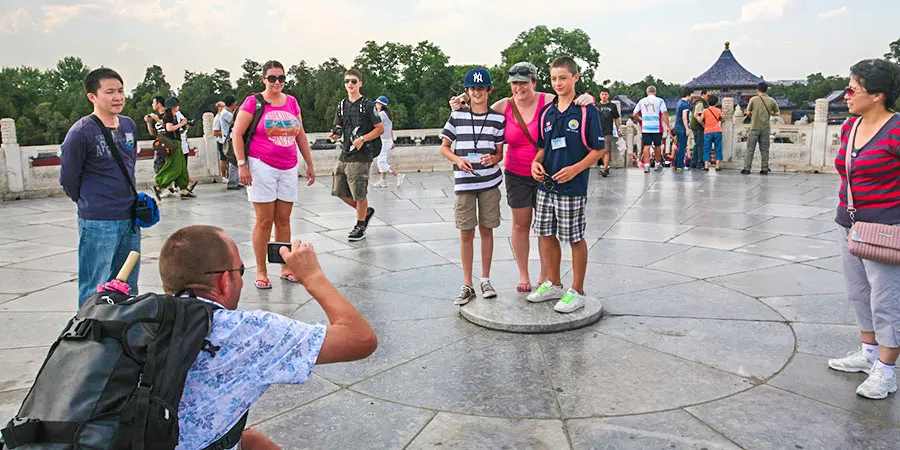 Three Echo Stones is outside of the gate of the Imperial Vault of Heaven. If you speak facing the Vault while standing on the first stone, you will hear one echo; standing on the second and then the third stone, you will hear two and three echoes respectively.
Three Echo Stones is outside of the gate of the Imperial Vault of Heaven. If you speak facing the Vault while standing on the first stone, you will hear one echo; standing on the second and then the third stone, you will hear two and three echoes respectively.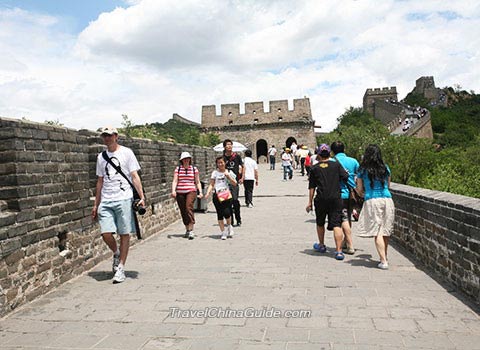 The
The  The Great wall originally functioned as a fortification. As early as the
The Great wall originally functioned as a fortification. As early as the 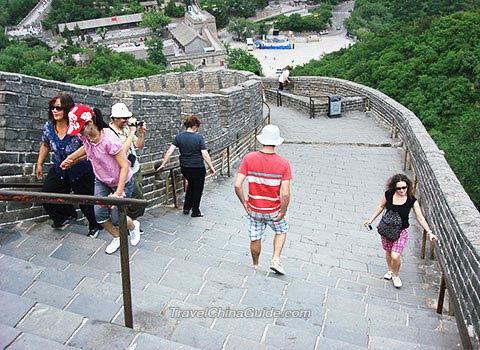 As a landmark erected at the top of a group of mountain ranges, Badaling Great Wall has also witnessed many significant historic events. The first emperor of the Qin Dynasty toured there, Yuan Taizu, the first emperor of
As a landmark erected at the top of a group of mountain ranges, Badaling Great Wall has also witnessed many significant historic events. The first emperor of the Qin Dynasty toured there, Yuan Taizu, the first emperor of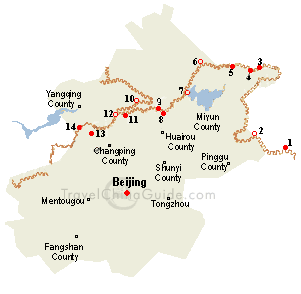
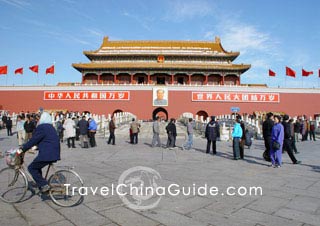 Located at the center of Beijing City is Tiananmen Square, where you can visit Tiananmen Tower, Monument to the People's Heroes, Great Hall of the People, Mao Zedong Memorial Hall and see the national flag raising ceremony. Thousands of people come to the Square every day. It is the must place to visit in Beijing City.
Located at the center of Beijing City is Tiananmen Square, where you can visit Tiananmen Tower, Monument to the People's Heroes, Great Hall of the People, Mao Zedong Memorial Hall and see the national flag raising ceremony. Thousands of people come to the Square every day. It is the must place to visit in Beijing City.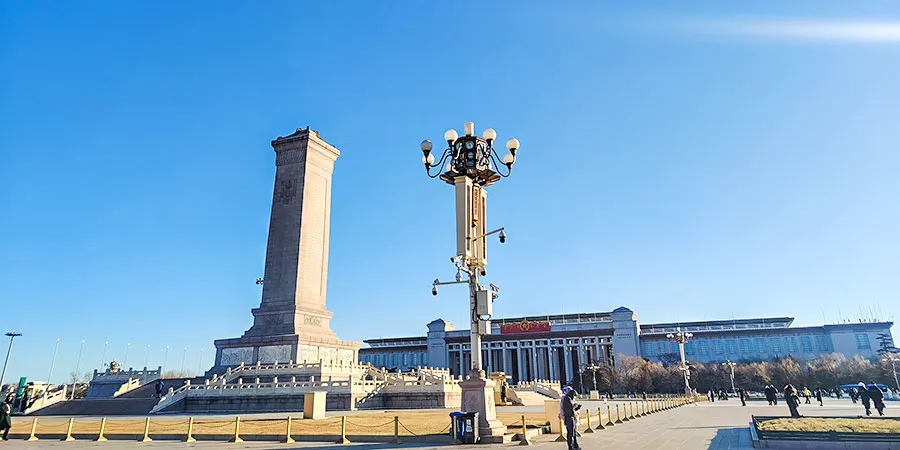 The granite Monument to the People's Heroes is just at the center of the Tiananmen Square. Built in 1952, it is the largest monument in China's history. ' The People's Heroes are Immortal' written by Chairman Mao is engraved on the monument. Eight unusually large relief sculptures show to the people the development of Chinese modern history. Two rows of white marble railings enclose the monument, simple and beautiful.
The granite Monument to the People's Heroes is just at the center of the Tiananmen Square. Built in 1952, it is the largest monument in China's history. ' The People's Heroes are Immortal' written by Chairman Mao is engraved on the monument. Eight unusually large relief sculptures show to the people the development of Chinese modern history. Two rows of white marble railings enclose the monument, simple and beautiful.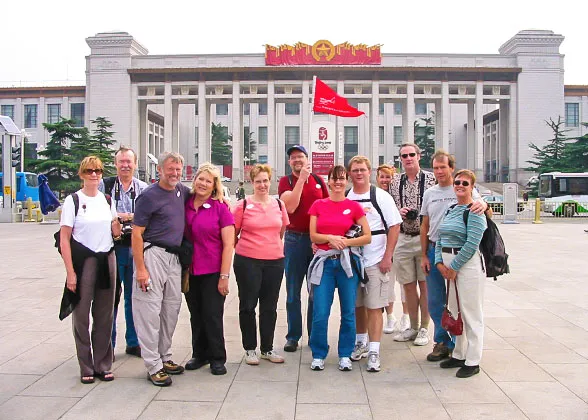 Mao Zedong Memorial Hall is at the south side of the Square. This Hall is divided into three halls and our dear Chairman Mao's body lies in a crystal coffin in one of the halls surrounded by fresh bouquets of various famous flowers and grasses.
Mao Zedong Memorial Hall is at the south side of the Square. This Hall is divided into three halls and our dear Chairman Mao's body lies in a crystal coffin in one of the halls surrounded by fresh bouquets of various famous flowers and grasses.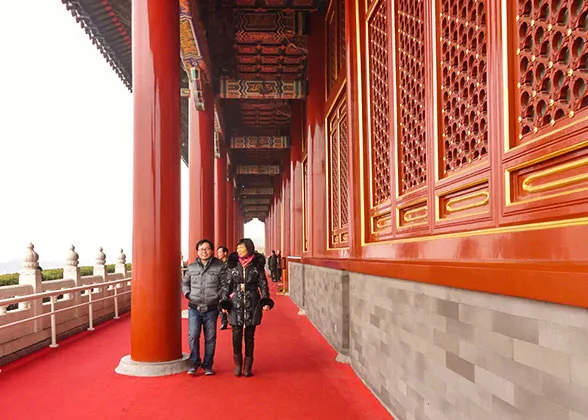 Five Star Red Flag-the Chinese national flag, flies high in the sky above the Square. To see the guard of honor raise the Flag is a must for the tourist visiting Beijing City. You have to get up very early and arrive at the Square before sunrise. Only by doing so can you see the ceremony clearly as there are crowds of people attending the ceremony every day.
Five Star Red Flag-the Chinese national flag, flies high in the sky above the Square. To see the guard of honor raise the Flag is a must for the tourist visiting Beijing City. You have to get up very early and arrive at the Square before sunrise. Only by doing so can you see the ceremony clearly as there are crowds of people attending the ceremony every day.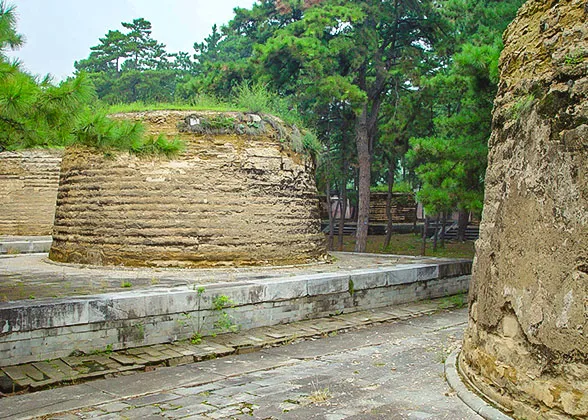 The Eastern Qing Tombs, a sacred burial ground near Beijing, is one of the two tomb areas devoted to the emperors, empresses and imperial concubines of the Qing Dynasty (1644-1911, the last feudal empire in China).The other is the
The Eastern Qing Tombs, a sacred burial ground near Beijing, is one of the two tomb areas devoted to the emperors, empresses and imperial concubines of the Qing Dynasty (1644-1911, the last feudal empire in China).The other is the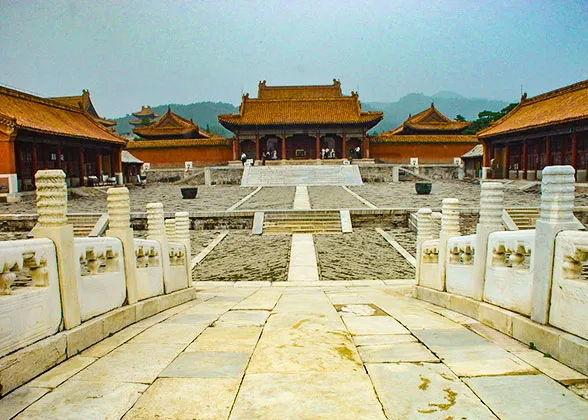 Of all the tombs, Xiaoling is the biggest and most elaborate, standing as the focal point of the entire structure. The grandeur of this tomb may be attributed to its having been the first sepulcher constructed for a member of the royal family of the Qing Dynasty, so the builders hoped to set the tone for a prosperous future. Crossing through the Great Red Gate, you can see buildings of different sizes, all with roofs of yellow glazed tile, connected by the brick paths or 'sacred ways' that converge in the area of Xiaoling.
Of all the tombs, Xiaoling is the biggest and most elaborate, standing as the focal point of the entire structure. The grandeur of this tomb may be attributed to its having been the first sepulcher constructed for a member of the royal family of the Qing Dynasty, so the builders hoped to set the tone for a prosperous future. Crossing through the Great Red Gate, you can see buildings of different sizes, all with roofs of yellow glazed tile, connected by the brick paths or 'sacred ways' that converge in the area of Xiaoling.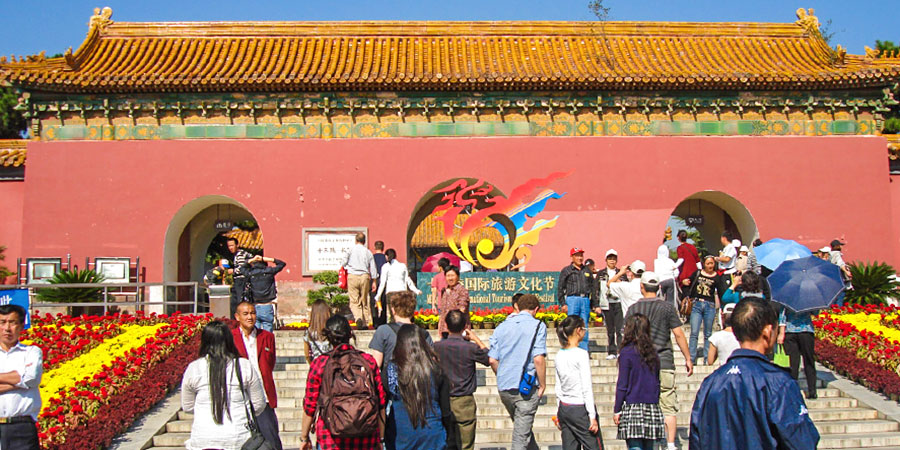
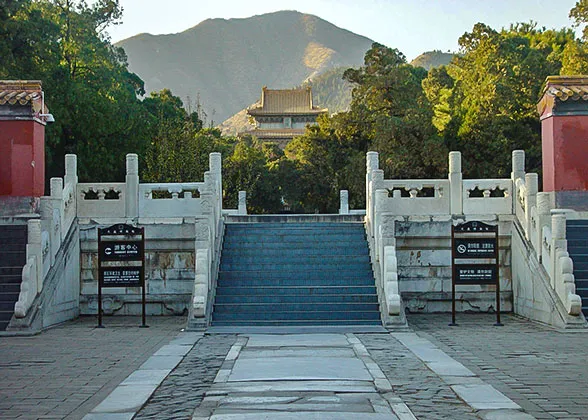
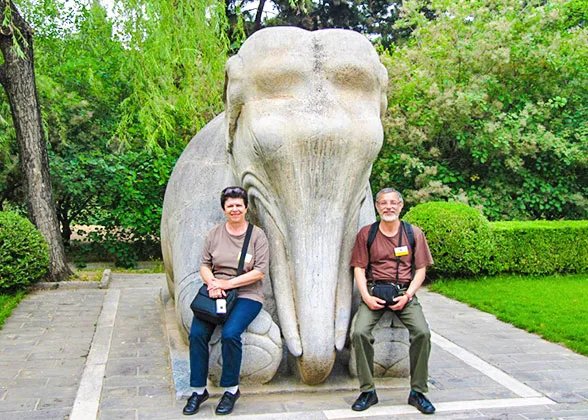 Unlike Changling, Dingling is under ground and about 27 meters deep. It is the mausoleum of Emperor Zhu Yijun, the thirteenth emperor who occupied the throne the longest during the Ming Dynasty, and his two empresses. The main features are the Stone Bridge, Soul Tower, Baocheng and the Underground Place, which was unearthed between 1956 and 1958. The entire palace is made of stone. The Soul Tower is symbolic of the whole of Dingling and it forms the entrance to the underground chambers. The yellow glazed tiles; eaves, archway, rafters and columns are all sculptured from stone, and colorfully painted. The entire construction is stable and beautiful!
Unlike Changling, Dingling is under ground and about 27 meters deep. It is the mausoleum of Emperor Zhu Yijun, the thirteenth emperor who occupied the throne the longest during the Ming Dynasty, and his two empresses. The main features are the Stone Bridge, Soul Tower, Baocheng and the Underground Place, which was unearthed between 1956 and 1958. The entire palace is made of stone. The Soul Tower is symbolic of the whole of Dingling and it forms the entrance to the underground chambers. The yellow glazed tiles; eaves, archway, rafters and columns are all sculptured from stone, and colorfully painted. The entire construction is stable and beautiful! The front hall, considered the square of the Palace, has no building within it. No special artifacts remain in either the left and right palaces that are about 7 meters high, six meters wide, and 26 meters long. However, each has a centrally placed white marble coffin bed, the surface of which is covered with gold bricks. On each bed there is a square hole filled with loess. This is the so-called "Gold Well". A paved path leads to the central hall where there are three white marble thrones. Incense, candles and flowers were set in front of the thrones. Before each of them, there are glazed 'Five Offerings' and a blue china jar that would have been filled with sesame oil to be used for lamps. The rear hall is the main and biggest part of the Palace. The coffins of Emperor Zhu Yijun and his two empresses are in this palace. There are also some precious items displayed with these coffins; among them is the gold imperial crown, one of the world's most rare treasures.
The front hall, considered the square of the Palace, has no building within it. No special artifacts remain in either the left and right palaces that are about 7 meters high, six meters wide, and 26 meters long. However, each has a centrally placed white marble coffin bed, the surface of which is covered with gold bricks. On each bed there is a square hole filled with loess. This is the so-called "Gold Well". A paved path leads to the central hall where there are three white marble thrones. Incense, candles and flowers were set in front of the thrones. Before each of them, there are glazed 'Five Offerings' and a blue china jar that would have been filled with sesame oil to be used for lamps. The rear hall is the main and biggest part of the Palace. The coffins of Emperor Zhu Yijun and his two empresses are in this palace. There are also some precious items displayed with these coffins; among them is the gold imperial crown, one of the world's most rare treasures.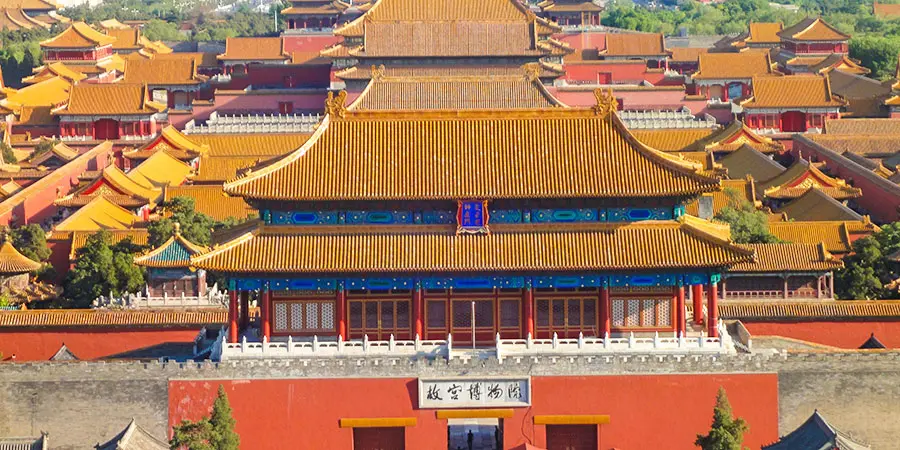 Lying at the center of Beijing, the Forbidden City, called Gu Gong in Chinese, was the imperial palace during the Ming and Qing dynasties. Now known as the Palace Museum, it is to the north of Tiananmen Square. Rectangular in shape, it is the world's largest palace complex and covers 74 hectares. Surrounded by a six meter deep moat and a ten meter high wall are 9,999 rooms. The wall has a gate on each side. Opposite the Tiananmen Gate, to the north is the Gate of Divine Might (Shenwumen), which faces Jingshan Park. The distance between these two gates is 960 meters, while the distance between the gates in the east and west walls is 750 meters. There are unique and delicately structured towers on each of the four corners of the curtain wall. These afford views over both the palace and the city outside. The Forbidden City is divided into two parts. The southern section, or the Outer Court was where the emperor exercised his supreme power over the nation. The northern section, or the Inner Court was where he lived with his royal family. Until 1924 when the last emperor of China was driven from the Inner Court, fourteen emperors of the Ming dynasty and ten emperors of the Qing dynasty had reigned here. Having been the imperial palace for some five centuries, it houses numerous rare treasures and curiosities. Listed by UNESCO as a World Cultural Heritage Site in 1987, the Palace Museum is now one of the most popular tourist attractions world-wide.
Lying at the center of Beijing, the Forbidden City, called Gu Gong in Chinese, was the imperial palace during the Ming and Qing dynasties. Now known as the Palace Museum, it is to the north of Tiananmen Square. Rectangular in shape, it is the world's largest palace complex and covers 74 hectares. Surrounded by a six meter deep moat and a ten meter high wall are 9,999 rooms. The wall has a gate on each side. Opposite the Tiananmen Gate, to the north is the Gate of Divine Might (Shenwumen), which faces Jingshan Park. The distance between these two gates is 960 meters, while the distance between the gates in the east and west walls is 750 meters. There are unique and delicately structured towers on each of the four corners of the curtain wall. These afford views over both the palace and the city outside. The Forbidden City is divided into two parts. The southern section, or the Outer Court was where the emperor exercised his supreme power over the nation. The northern section, or the Inner Court was where he lived with his royal family. Until 1924 when the last emperor of China was driven from the Inner Court, fourteen emperors of the Ming dynasty and ten emperors of the Qing dynasty had reigned here. Having been the imperial palace for some five centuries, it houses numerous rare treasures and curiosities. Listed by UNESCO as a World Cultural Heritage Site in 1987, the Palace Museum is now one of the most popular tourist attractions world-wide.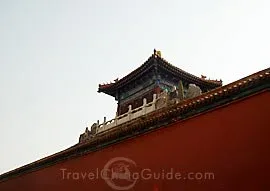 Construction of the palace complex began in 1407, the 5th year of the Yongle reign of the third emperor of the Ming dynasty. It was completed fourteen years later in 1420. It was said that a million workers including one hundred thousand artisans were driven into the long-term hard labor. Stone needed was quarried from Fangshan, a suburb of Beijing. It was said a well was dug every fifty meters along the road in order to pour water onto the road in winter to slide huge stones on ice into the city. Huge amounts of timber and other materials were freighted from faraway provinces. Ancient Chinese people displayed their very considerable skills in building the Forbidden City. Take the grand red city wall for example. It has an 8.6 meters wide base reducing to 6.66 meters wide at the top. The angular shape of the wall totally frustrates attempts to climb it. The bricks were made from white lime and glutinous rice while the cement is made from glutinous rice and egg whites. These incredible materials make the wall extraordinarily strong.
Construction of the palace complex began in 1407, the 5th year of the Yongle reign of the third emperor of the Ming dynasty. It was completed fourteen years later in 1420. It was said that a million workers including one hundred thousand artisans were driven into the long-term hard labor. Stone needed was quarried from Fangshan, a suburb of Beijing. It was said a well was dug every fifty meters along the road in order to pour water onto the road in winter to slide huge stones on ice into the city. Huge amounts of timber and other materials were freighted from faraway provinces. Ancient Chinese people displayed their very considerable skills in building the Forbidden City. Take the grand red city wall for example. It has an 8.6 meters wide base reducing to 6.66 meters wide at the top. The angular shape of the wall totally frustrates attempts to climb it. The bricks were made from white lime and glutinous rice while the cement is made from glutinous rice and egg whites. These incredible materials make the wall extraordinarily strong.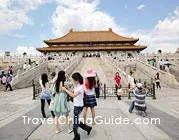 The magnificent
The magnificent 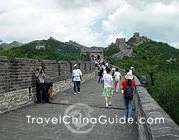 The Great Wall is one of the 'Eight Wonders of the World' and is enlisted in the World Heritage Directory. This immense wall was built to keep out invaders as well as to retain the inhabitants. It spans five provinces (6,700 kilometers, or 2,587 miles) from Shanhaiguan Pass in the east to Jiayuguan Pass in the west. Like a gigantic dragon, it winds up and down across deserts, grasslands and mountains and said to be the only man-made structure that can be seen from the moon.
The Great Wall is one of the 'Eight Wonders of the World' and is enlisted in the World Heritage Directory. This immense wall was built to keep out invaders as well as to retain the inhabitants. It spans five provinces (6,700 kilometers, or 2,587 miles) from Shanhaiguan Pass in the east to Jiayuguan Pass in the west. Like a gigantic dragon, it winds up and down across deserts, grasslands and mountains and said to be the only man-made structure that can be seen from the moon. 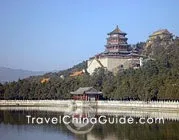 For a peaceful and interesting stroll, visit Beijing's many beautiful parks, such as
For a peaceful and interesting stroll, visit Beijing's many beautiful parks, such as 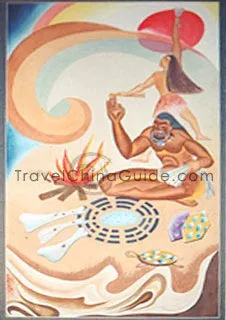 In Chinese history, the Paleolithic Age is the earliest, beginning approximately 3,000,000 years ago and ending 10,000 years ago. Human beings during this period produced mainly simple stone implements, so the age is called the Paleolithic Age.
In Chinese history, the Paleolithic Age is the earliest, beginning approximately 3,000,000 years ago and ending 10,000 years ago. Human beings during this period produced mainly simple stone implements, so the age is called the Paleolithic Age.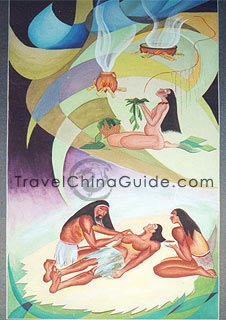 The appearance of the humans in the late period was almost as the same as that of modern humans. They belonged to the latter Homo sapiens. Tools were more advanced than before. Beating, polishing and drilling were used extensively. Implements looked symmetrical and clearly reflect their different purposes. Bow and arrow, rock spear, drill, awls, carving implements and some utensils for daily use made from bone appeared at that time. In addition, decorations created with rocks, bones, animal teeth and ostrich eggshells appeared, among which some were even dyed with colors. As for the marriage system, because of the establishment of the clan, no person in a clan was allowed to marry a person of a different clan.
The appearance of the humans in the late period was almost as the same as that of modern humans. They belonged to the latter Homo sapiens. Tools were more advanced than before. Beating, polishing and drilling were used extensively. Implements looked symmetrical and clearly reflect their different purposes. Bow and arrow, rock spear, drill, awls, carving implements and some utensils for daily use made from bone appeared at that time. In addition, decorations created with rocks, bones, animal teeth and ostrich eggshells appeared, among which some were even dyed with colors. As for the marriage system, because of the establishment of the clan, no person in a clan was allowed to marry a person of a different clan.

